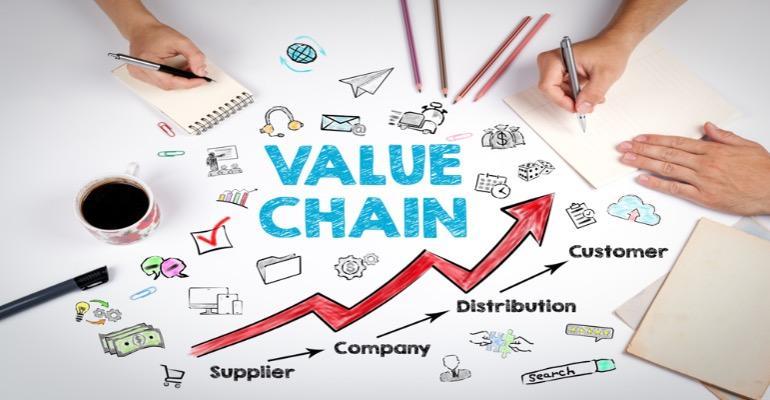Imagine you have a favourite product, let’s say a smartphone. The journey of that smartphone from raw materials to your hands involves a series of interconnected activities, each adding value to the final product. This entire sequence of activities is called a value chain. It serves as a roadmap that outlines the journey from procuring raw materials to delivering the final product. This blog will cover everything you need to know about a value chain, from its meaning to analysis.
Value chain meaning
The primary objective of a value chain is to establish a competitive advantage for businesses. But what is a value chain?
Michael E. Porter introduced the concept of a value chain in his seminal work, “Competitive Advantage: Creating and Sustaining Superior Performance.” Porter emphasised that competitive advantage arises from a company’s discrete activities in designing, producing, marketing, delivering, and supporting its product. A value chain is a concept in business that describes the full range of activities a company goes through to bring a product or service from its conception to delivery to the end consumer. It includes all the stages of production, from the extraction or creation to the delivery of the product or service.
By refining efficiency at every stage, companies can outperform competitors in terms of both product quality and cost-effectiveness. The overarching goal is to create a superior offering for the consumer while maintaining reasonable production costs.
Value chain model
The value chain model is a strategic framework that systematically breaks down a company’s activities into primary and support activities, each adding value to the product or service. Here are the key components of the value chain model:
1. Primary activities
Primary activities include the core functions directly involved in creating, producing, and delivering a product. These activities are typically categorized into five main components:
-Inbound logistics: Inbound logistics refers to the intricate processes of receiving, storing, and managing raw materials. Effective management of inbound logistics leads to cost savings and improvements in operational efficiency.
-Operations: Operations represent the critical phase where raw materials are transformed into the final product. Optimising operations is necessary for maintaining product quality while managing production costs effectively.
-Outbound logistics: Efficient outbound logistics is vital for the timely and cost-effective distribution of the final product, contributing significantly to customer satisfaction and loyalty.
-Marketing and sales: Marketing and sales include strategic activities to increase product visibility and attract customers. Proficiency in these areas results in improved brand recognition and sustained customer loyalty.
-Service: Post-sales service involves addressing customer needs, maintaining products, and continual refinement. Excellent service enhances customer experience and creates long-term relationships.
2. Secondary activities
Secondary activities are the supporting functions that enhance the effectiveness of primary activities. These include:
– Procurement: Procurement involves acquiring the necessary raw materials. Judicious procurement decisions can positively impact cost, quality, and the overall reliability of the supply chain.
-Technological development: It refers to innovation that enhances products or processes. Effective technology integration provides a competitive edge, driving operational efficiency and market leadership.
-HR Management: Human Resources Management focuses on acquiring, training, and retaining skilled employees aligned with the company’s objectives. A motivated and proficient workforce contributes significantly to business excellence.
-Infrastructure: Infrastructure encompasses the organisational structure, systems, and support functions. Efficient infrastructure management is paramount for seamless operations, effective decision-making, and overall business success.
The value chain model is an excellent tool for businesses to understand their internal processes and identify areas for improvement, cost reduction, or differentiation.
Value chain analysis
Value chain analysis is a strategic management approach that involves meticulously examining each activity within a company’s value chain to assess its impact on value creation and the overall cost structure. Here are the steps involved in value chain analysis:
1. Identify primary and support activities: Determine both primary and support activities that constitute the entire value chain. These encompass every step involved in creating a product or service.
2. Evaluate value and cost: Analyse each activity’s value to customers and the overall business and how well they align with the desired competitive advantage. Simultaneously, scrutinise the costs associated with each activity, considering factors like labour intensity and raw material expenses.
3. Leverage competitors’ insights: Explore your competitors’ value chains through competitive benchmarking. This multifaceted approach involves strategic benchmarking, process benchmarking, and performance benchmarking.
4. Understand customer perception: Recognise the paramount role of customer perception in shaping your competitive advantage. Utilise customer surveys and other tools to gauge how your target market perceives your product’s value.
5. Identify opportunities for advantage: With a holistic view from the value chain analysis, identify areas of excellence and operational improvement. Prioritise minor changes that yield significant impacts, followed by tackling more substantial challenges hindering efficiency.
Various tools and frameworks support this process:
1. SWOT analysis: Strengths and weaknesses focus on internal factors such as operational efficiency and resource utilisation, while opportunities and threats centre around external factors, like market trends and competitive forces. By identifying these factors, companies can gain insights into areas of competitive advantage and potential vulnerabilities.
2. Cost advantage and differentiation: Companies keenly assess the costs associated with each activity within the value chain to determine whether they possess a cost advantage over competitors. This involves thoroughly evaluating operational expenses, production costs, and supply chain expenditures. Simultaneously, the analysis identifies opportunities for differentiation, allowing companies to enhance the uniqueness of their products or services in the market and stand out among competitors.
3. Benchmarking: Benchmarking is a valuable tool that enables companies to compare their performance against industry benchmarks and competitors. It offers a quantitative and qualitative assessment of a company’s efficiency and effectiveness.
4. Value chain mapping: This involves mapping out each stage of the value chain, from raw material acquisition to product/service delivery. Value chain mapping helps identify potential bottlenecks or areas for improvement in the overall operational process.
5. Technology integration: Value chain analysis includes exploring opportunities to integrate technology into various activities. This integration can range from implementing advanced manufacturing processes to adopting data analytics for the supply chain. Leveraging technology within the value chain enhances overall efficiency and ensures that companies remain at the forefront of innovation.
6. Collaboration and partnerships: No company operates in isolation. Collaboration and partnerships are integral components of value chain analysis. Evaluate opportunities for collaboration with suppliers, distributors, or other partners to streamline and improve the value chain. This collaborative approach enhances overall efficiency and strengthens relationships across the supply chain.
Don’t let financial strain overcome your business operations
The value chain model helps businesses understand and optimise their internal processes, driving sustainable competitive advantage. It outlines the production process and the entire journey from raw materials to customer satisfaction.
But amidst the pursuit of operational excellence, securing a reliable partner for financial support is imperative. Whether it’s streamlining procurement, investing in technology, or fortifying human resource capabilities, Tata Capital’s Business Loan aligns seamlessly with the diverse needs of businesses.
With Tata Capital as a financial ally, you can easily dissect and refine your value chain and confidently implement strategic initiatives. Apply for a Business Loan with Tata Capital online loan app today to enjoy competitive interest rates, high loan amounts, and flexible terms.


 6 mins read
6 mins read

 Previous Post
Previous Post













